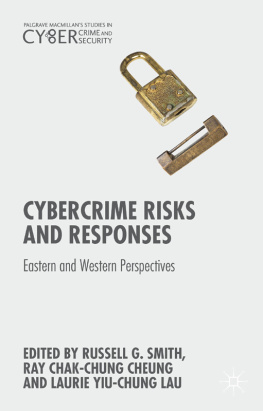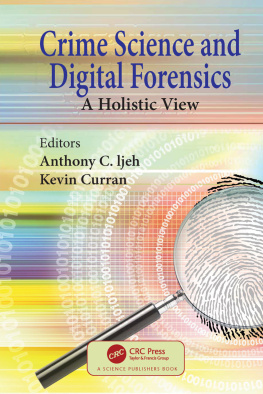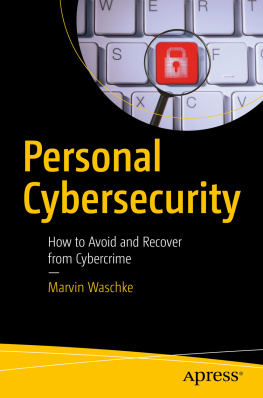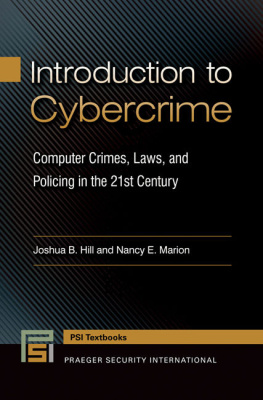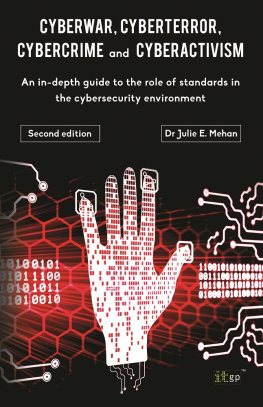Cybercrime Risks and Responses
Palgrave Macmillans Studies in Cybercrime and Cybersecurity
This book series addresses the urgent need to advance knowledge in the fields of cybercrime and cybersecurity. Because the exponential expansion of computer technologies and use of the Internet have greatly increased the access by criminals to people, institutions, and businesses around the globe, the series will be international in scope. It provides a home for cutting-edge long-form research. Further, the series seeks to spur conversation about how traditional criminological theories apply to the online environment. The series welcomes contributions from early career researchers as well as established scholars on a range of topics in the cybercrime and cybersecurity fields.
Series Editors:
MARIE-HELEN MARAS is Associate Professor and Deputy Chair for Security at the Department of Security, Fire, and Emergency Management at John Jay College of Criminal Justice, USA.
THOMAS J. HOLT is Associate Professor in the School of Criminal Justice at Michigan State University, USA.
Titles include:
Amitai Etzioni
PRIVACY IN CYBER AGE
Policy and Practice
Frederic Lemiux (editor)
CURRENT AND EMERGING TRENDS IN STRATEGIC CYBER OPERATIONS
Policy, Strategy and Practice
Russell G. Smith, Ray Chak-Chung Cheung and Laurie Yiu-Chung Lau (editors)
CYBERCRIME RISKS AND RESPONSES
Eastern and Western Perspectives
Cybercrime Risks and Responses
Eastern and Western Perspectives
Edited by
Russell G. Smith
Australian Institute of Criminology
Ray Chak-Chung Cheung
City University of Hong Kong, Hong Kong SAR
Laurie Yiu-Chung Lau
Asia Pacific Association of Technology and Society, Hong Kong SAR


Introduction, selection and editorial matter Russell G. Smith, Ray Chak-Chung Cheung and Laurie Yiu-Chung Lau 2015
Foreword Charles Mok 2015
Remaining chapters Contributors 2015
All rights reserved. No reproduction, copy or transmission of this publication may be made without written permission.
No portion of this publication may be reproduced, copied or transmitted save with written permission or in accordance with the provisions of the Copyright, Designs and Patents Act 1988, or under the terms of any licence permitting limited copying issued by the Copyright Licensing Agency, Saffron House, 6-10 Kirby Street, London EC1N 8TS.
Any person who does any unauthorized act in relation to this publication may be liable to criminal prosecution and civil claims for damages.
The authors have asserted their rights to be identified as the authors of this work in accordance with the Copyright, Designs and Patents Act 1988.
First published 2015 by
PALGRAVE MACMILLAN
Palgrave Macmillan in the UK is an imprint of Macmillan Publishers Limited, registered in England, company number 785998, of Houndmills, Basingstoke, Hampshire, RG21 6XS.
Palgrave Macmillan in the US is a division of St Martins Press LLC, 175 Fifth Avenue, New York, NY 10010.
Palgrave Macmillan is the global academic imprint of the above companies and has companies and representatives throughout the world.
Palgrave and Macmillan are registered trademarks in the United States, the United Kingdom, Europe and other countries.
ISBN: 9781137474155
This book is printed on paper suitable for recycling and made from fully managed and sustained forest sources. Logging, pulping and manufacturing processes are expected to conform to the environmental regulations of the country of origin.
A catalogue record for this book is available from the British Library.
A catalog record for this book is available from the Library of Congress.
For
Melinda,
Vicky, and Raisie
and
Lau Cheung Kwai Lan and Lam Ding Kwong, at peace
Contents
In the summer of 2013, the International Conference on Cyber Crime and Computer Forensic was held by the Asia Pacific Association of Technology and Society (APATAS) in Hong Kong, and I had the privilege of meeting experts and researchers in the field of cybercrime. Several important themes have emerged from that dialogue. The proliferation of cybercrime has grown at an unprecedented speed, and as a Legislative Council member representing the information technology sector and an advocate for a free and open Internet, I am glad to witness the immense effort put into the preparation of this volume of research addressing Eastern and Western perspectives on cybercrimes.
Cybercrimes are increasingly sophisticated and organized, and the stakes are becoming higher. As shown in the hacks of bitcoin exchange and a US film company, skilled terrorist groups and hacktivists are becoming more active. Cybercrime has also evolved into a tool of chasing big money, stealing confidential information, and even making a political stand. The days when the stereotypical hackers were curious, tech-savvy coders trying to prove their skills are now far behind. Cybercrime has evolved in scale and format, with both unauthorized access to information and dissemination of illegal content being common across borders. The cost of cybercrime to individuals, corporations, and governments skyrockets, and the resources needed to trace, attribute, and convict criminals have also grown. Meanwhile, authorities and law enforcement agencies are often outpaced by the speed and skill of criminals, making policing an outsized challenge. At this juncture, the need for a systematic study on the trends, risks, and implications of cybercrimes as well as other emerging trends on social network is becoming ever more pressing.
This publication is highly relevant to not only academic researchers on cybercrime; it also offers visionary assessments for those in arenas potentially affected by technology criminals and for those decision-makers who would like to deepen their understanding of the issues. Its balanced blend of updated perspectives, inclusion of different response tactics used in countries with different cultures, and the contributors observations on how cyber terrorism, organized cybercrime, and technology-enabled financial crimes will further evolve, provide readers with solid discussions and sharp insights on the issues. Throughout the chapters, there is a discussion on risk profiles in different regions and their varied models of response through prevention and enforcement activities across East and West. Themes that emerged from the conference in 2013, including cybercrime versus national security, cyber-crowdsourcing versus privacy, hacktivism and human rights versus government transparency and openness are well discussed in depth in essays of this book, and they are of the utmost significance in todays evolving cybercrime landscape.
Contemporary risks explored in this volume including threats to national security, spam, cyber terrorism, fraud, and sexually explicit content are challenges common to countries regardless of location. Some call cybercrime a new industry not entirely an exaggeration, for the revenue criminals are making from it. In 2011, Britain's Office of Cyber Security and Information Assurance reported that the total cost of cybercrime to the British economy was 27 billion (or USD$43.5 billion) per year (Detica and Office of Cyber Security and Information Assurance 2011). As security software company McAfee puts it, cybercrime is a growth industry with high returns and low risks. Their estimation in 2014 reported an approximate annual cost of cybercrimes to the global economy of more than USD$400 billion (McAfee and Center for Strategic and International Studies 2014).
Next page
